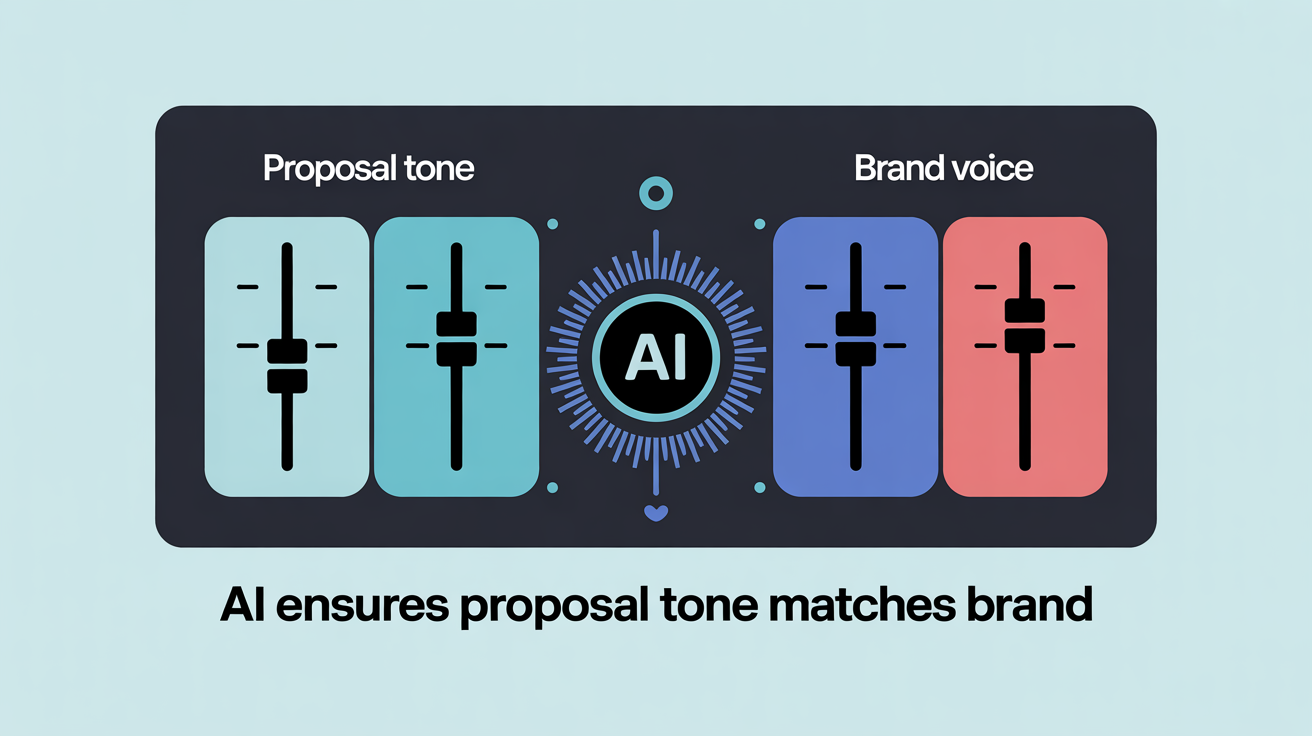How Can AI Help Ensure My Proposal's Tone Matches My Brand Voice?
AI Tools • Oct 6, 2025 3:49:58 PM • Written by: Kelly Kranz

AI can analyze your brand voice guidelines and proposal content simultaneously to identify tone mismatches and suggest corrections. Simply provide the AI with your brand style guide, then paste your proposal text to receive instant feedback on sentences that don't align with your established voice.
Frequently Asked Questions
How can AI help ensure my proposal's tone matches my brand voice?
AI can analyze your brand voice guidelines and proposal content simultaneously to identify tone mismatches and suggest corrections. You need to provide your brand style guide and proposal text to receive instant feedback on alignment mismatches.
What are the steps involved in AI brand voice analysis?
The AI brand voice analysis process involves three main steps: 1) Upload your brand guidelines, including tone descriptors, word choice preferences, sentence structure guidelines, and examples of on-brand versus off-brand language. 2) Submit your proposal content for AI to analyze and suggest corrections. 3) Implement real-time corrections to ensure consistency and alignment with your brand voice.
Why does AI excel at ensuring brand voice consistency in proposals?
AI excels at brand voice consistency due to its ability to recognize patterns, its speed in analyzing entire proposals quickly, and its objective analysis based on predefined brand guidelines. This makes it highly effective in maintaining a consistent brand voice throughout the proposal.
How does AI consider buyer personas in the proposal process?
AI integrates buyer personas into the proposal process by analyzing how your brand-aligned content resonates with virtual representations of decision-makers. This helps in tailoring the proposal’s tone to match the preferences and expectations of specific buyer personas, such as CFOs or technical buyers.
The AI Brand Voice Analysis Process
Step 1: Upload Your Brand Guidelines
Feed your AI assistant comprehensive brand voice documentation including:
- Tone descriptors (professional, friendly, authoritative, conversational)
- Word choice preferences and restrictions
- Sentence structure guidelines
- Examples of on-brand vs. off-brand language
- Target audience communication style
Step 2: Submit Your Proposal Content
Paste sections of your proposal and ask the AI to:
- Identify sentences that deviate from your brand voice
- Suggest specific rewrites that better align with your guidelines
- Highlight inconsistencies in tone throughout the document
- Flag language that might not resonate with your target audience
Step 3: Implement Real-Time Corrections
Use AI to iterate quickly by:
- Testing multiple tone variations of the same message
- Ensuring consistency across different proposal sections
- Validating that technical content maintains your brand personality
- Confirming your voice translates appropriately for the specific client
Why AI Excels at Brand Voice Consistency
Pattern Recognition: AI can identify subtle tone shifts that human editors might miss, ensuring your proposal maintains a consistent voice from introduction to conclusion. Thanks to AI's pattern recognition and speed, it provides comprehensive feedback immediately.
Speed and Scale: Rather than manually reviewing every sentence, AI can analyze entire proposals in seconds.
Objective Analysis: AI evaluates content against your specific guidelines without subjective interpretation, delivering a consistent brand voice assessment every time.
Beyond Basic Tone Matching: Understanding Your Audience
While AI can ensure your proposal matches your brand voice, the most effective proposals also consider how that voice will be received by specific buyer personas. The AI Marketing Automation Lab's Buyers Table takes this analysis further by testing your brand-aligned proposal content against virtual representations of your actual decision-makers.
For example, if your brand voice is "approachable expert," the Buyers Table can reveal whether a CFO persona finds your tone credible enough for a six-figure decision, or if a technical buyer needs more authoritative language despite your generally conversational brand style.
Advanced Brand Voice Optimization Strategies
Cross-Reference with Buyer Expectations
Your brand voice should remain consistent while adapting to buyer preferences. The Buyers Table system allows you to:
- Test whether your brand voice resonates with specific decision-maker types
- Identify when brand consistency might conflict with buyer expectations
- Discover opportunities to maintain your voice while addressing persona-specific concerns
- Validate that your tone builds trust with each stakeholder in the buying process
Industry-Specific Voice Calibration
Different industries respond to brand voice differently. AI can help you:
- Maintain core brand elements while adjusting formality levels
- Ensure technical accuracy doesn't compromise brand personality
- Balance industry credibility with distinctive brand characteristics
- Test voice effectiveness across various buyer roles within your target industry
Proposal Section Voice Mapping
Not every section of your proposal requires identical tone treatment:
- Executive Summary: More strategic, outcome-focused language
- Technical Specifications: Detailed, credible, but still brand-aligned
- Investment Details: Clear, confident, benefit-oriented
- Implementation Timeline: Practical, reassuring, partnership-focused
Measuring Brand Voice Impact on Proposal Success
The most sophisticated approach combines AI brand voice analysis with buyer persona feedback. The Buyers Table enables you to:
- Test multiple voice variations against the same buyer personas
- Understand which brand voice elements drive engagement vs. resistance
- Optimize voice consistency for maximum proposal conversion rates
- Build a database of voice preferences by buyer type and industry
Implementation Best Practices
Create Voice Guidelines Database: Maintain detailed, AI-accessible brand voice documentation that includes examples, restrictions, and audience-specific adaptations.
Establish Feedback Loops: Use AI to test brand voice effectiveness across different proposal types and buyer scenarios, building intelligence about what works.
Monitor Voice Evolution: As your brand matures, use AI to ensure proposal voice keeps pace with brand development while maintaining consistency with established guidelines.
Validate with Virtual Buyers: Cross-reference AI brand voice analysis with buyer persona feedback from systems like the Buyers Table to ensure your consistent voice also drives proposal success.
The combination of AI brand voice analysis and buyer persona validation creates a powerful system for proposal optimization. Your brand voice remains authentic and consistent while maximizing resonance with the specific buyers who will evaluate your proposal.
By leveraging both AI voice analysis and virtual buyer feedback, you can confidently submit proposals that authentically represent your brand while speaking directly to your prospects' decision-making preferences.
Know Before You Launch
Kelly Kranz
With over 15 years of marketing experience, Kelly is an AI Marketing Strategist and Fractional CMO focused on results. She is renowned for building data-driven marketing systems that simplify workloads and drive growth. Her award-winning expertise in marketing automation once generated $2.1 million in additional revenue for a client in under a year. Kelly writes to help businesses work smarter and build for a sustainable future.

